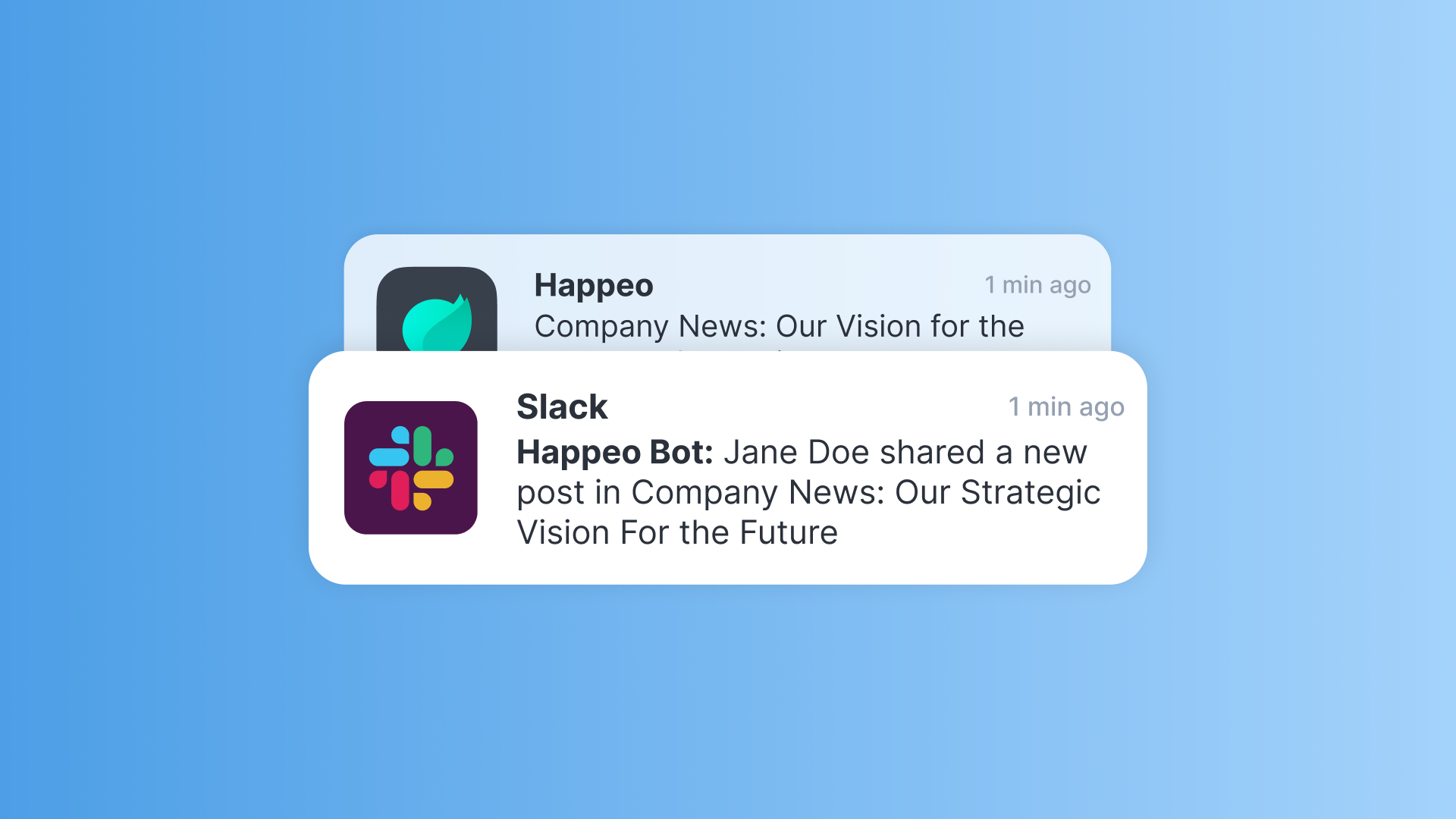

Jonathan Davies
13 mins read
Table of Contents
- Where is an intranet used?
- Intranet use case 1: an Intranet Content Management System
- Intranet use case 2: a Social Intranet
- Intranet use case 3: Mobile Intranet Apps
- Create an intranet Intranet use case 4: Transform your Corporate Culture your staff will love
- Intranet use case 5: an approachable and user-friendly workplace
- Intranet use case 6: third-party intranet solutions
- Intranet use case 7: a Digital Workplace
- Determining when an intranet is a good fit for you
Start building your digital home with Happeo
Request a demoInternal Communications is at the centre of digital transformation. Enterprise intranet software is a tool to break down communication barriers, improve collaboration and drive productivity.
74% of employees have the feeling they are missing out on company information and news. It can be quite frustrating for employees when they are not informed about organizational news. At the same time, productivity in an organization increases by 20 to 25% when employees are connected. For companies that means to rethink the way they communicate and engage with their employees.
How does an intranet software work?
Watch video
Where is an intranet used?
While most enterprise intranets have progressed into this new digital age, intranets can be used in different ways: to improve communications, employee collaboration, knowledge management, workflows and overall productivity.
The varying features and functions of intranet services will make each intranet look different for users. To understand what it looks like in action, you need to compare enterprise intranet solutions based on their capabilities. In this article we explore a variety of intranet examples and how intranets are used. Each use case is highlighting a different feature that gives insight into what an intranet will look like and how it helps your enterprise.
Intranet use case 1: an Intranet Content Management System
An Intranet CMS focuses on creating and managing digital content for your business. It also manages the content of your website. While CMS systems have been around since the nineties, they have since evolved into a flexible, user-friendly web-based system that can integrate with your intranet. An intranet meant as a CMS will provide you with the following benefits:
- Document management and data storage
- Information publishing across the enterprise
- Customizable sitemap and navigation with customizable modules
- Integration with third-party tools
- Collaborative work space for employees
- Providing virtual meeting space
- Increased enterprise search and navigation tools for information
- Format management features to ensure publishing consistency
Where enterprise information was once scattered, a CMS intranet will provide a distinct intranet service that is easy to use and navigate for your team. With all of the information and content stored in one central area, CMS intranets allow for data to be quickly accessible to any and all intranet users. Employees can create and contribute content easily, which opens up the doors of communication within your workplace. With a CMS intranet use, your enterprise will see a decline in printing and paper costs, an increase in time efficiency and employee productivity, and an increase in controlled information sharing on a company-wide level. CMS intranets allow for collaboration, cooperation, content storage and content access all in one digital workspace.
Intranet use case 2: a Social Intranet
Social media permeates the modern-day culture, and intranets are no exception. To boost efficiency in your workplace and enhance employee collaboration, enterprise intranets can be used as a mean for socializing for your staff. An example of what a social intranet will do is integrate communication tools with personal profiles, a powerful search engine and sharing and reaction features. All of this in one digital space, providing a holistic social and collaborative experience for your staff. You will see specific features in an example of a social intranet such as:
- A social portal homepage that provides a search of employee profiles
- Modern social features such as @mentions, hashtags, comments, liking, etc.
- Integration with other social media tools already in use
- Easy to create and share multimedia content
- Mobile intranet app inclusion and capability for continued connection
Imagine taking the features from popular, relevant social media apps and putting them into the context of a workplace. Commenting, posting, and sharing information instantaneously keeps your employees up-to-date, while also utilizing features they are comfortable with. This will boost your employee engagement and help overall morale by giving people a space for their voice.
.jpg?width=1132&name=3-Visual%20(1).jpg) Regarding intranet trends and norms, Nielsen Norman Group’s findings on social tool integration state that there was little training required, that communities normally “police themselves” so topics stay on track through the use of ‘community managers’, and that “even a few active contributors can add substantial value to the entire organization.” They saw the value in utilizing social media tools to engage employees, and they stated that there is “no doubt that social features are even more useful inside the enterprise for the support of employee collaboration and knowledge management.”
Regarding intranet trends and norms, Nielsen Norman Group’s findings on social tool integration state that there was little training required, that communities normally “police themselves” so topics stay on track through the use of ‘community managers’, and that “even a few active contributors can add substantial value to the entire organization.” They saw the value in utilizing social media tools to engage employees, and they stated that there is “no doubt that social features are even more useful inside the enterprise for the support of employee collaboration and knowledge management.”
Employee collaboration and social intranet tools are especially useful for global enterprises that are looking to connect intranet users from all around the globe. A virtual, social space will open communication between employees who may be in search of someone with a specific skill set, and connecting them will increase productivity and efficiency in the workplace.
The idea behind a socially collaborative system is to start a conversation within your enterprise and move away from the one-sided, top-down communication of the past.
Intranet use case 3: Mobile Intranet Apps
The workplace has changed. Employees have become more dispersed and with remote working on the rise work gets done everywhere, anytime. With that cultural shift comes the expectation of having access to what you need to get your job done from any of your devices – including your mobile phone. Intranets can now provide mobile intranet apps that allow your employees to check in and weigh in on company matters from wherever they are. The improved, faster intranet connection capabilities make logging in and working from anywhere easy. For example, an intranet mobile app will provide:
- Full access to the intranet system from your employee’s mobile device
- User-friendly, responsive web interface and app
- Interactive employee directory and full social features
- Notifications that are sent to mobile devices from management to update employees 24/7
- Higher involvement of intranet usage and engagement from employees due to increased accessibility
- Integration with other mobile apps and business tools
.jpg?width=1794&name=12-Visual%20(1).jpg)
Keeping your employees connected at all times is what intranet 2.0 is all about, and the mobile intranet app feature continues to propel that movement forward. Employees who are constantly on-the-go, traveling, or otherwise away from their desk can stay connected to the larger enterprise activities through their phone. This creates a better, more consistent flow of communication throughout the organization and increases time efficiency. Many examples of intranet mobile apps will also allow for integration with other apps on your phone (Google Calendar, Docs, Email), so the enterprise intranet portal remains the one-stop-shop for everything your employees will need to get done or be updated on.
Discover all the features of an intranet software
Download list
Intranet use case 4: Transform your Corporate Culture
You work hard to create an identifiable brand, but without reinforcement that brand can be lost internally. Enterprise intranets create a space to positively reinforce company-wide culture and teamwork through specific and pointed information and interactions shared. Not only does this help cultivate your brand, but it helps your employees to feel included and that they belong to a bigger picture and goal. Some example features of enterprise intranet software that will boost culture are:
- Ways to quickly celebrate successes of employees
- Ability to post content that shows employees what your company values are
- Allows for new employees to see how the company functions and how employees interact
- Breaks down silos and division that can be created by using isolated SaaS collaboration tools
- Reinforcing a culture of the importance of communication through social media tools and dynamic, two-way communication methods
While an enterprise intranet itself will not create culture within your workplace, if you use it wisely, you can establish a hub to reinforce cultural values of your enterprise. Basically, your intranet is your culture conduit. When positivity throughout the intranet is maintained, employees will follow suit and continue the trend set by the intranet culture. The user-generated intranet content will reflect the general attitude of the workplace, and if the intranet is used to appreciate and value employees, then that is what will continue to be pushed throughout the company.
Intranet use case 5: an approachable and user-friendly workplace
Having a dynamic business means having staff that ranges in skill set and expertise. Enterprise intranets are the perfect example of a service that reaches across your entire workforce so any employee from any department can use the intranet software with ease. Formatting tools and templates allow for consistent work and content from every employee, and also cuts down on the time that it takes to build and format documents from scratch.
With everything in one centralized location, accessing information is streamlined and simplified. Intranet software can also be customized based on specific needs of your employee demographic, meaning you can cater to your employees’ distinct skills when implementing an intranet. Accessibility-feature examples in an intranet software include:
- Branding options to keep your name out there consistently and professionally
- Ability to create, format, and share content without using coding or HTML
- More accurate search engines
- Access to all types of employee forms such as PTO, expense reports, insurance forms, etc.
- User-friendly navigation and UI
- Artificial Intelligence (AI) features for virtual assistance
.jpg?width=1156&name=1-Header_2%20(1).jpg) The user-centric capability of an enterprise intranet solution can be a huge benefit to your enterprise. Creating, designing, or choosing a software that is tailor-made for your employees will not only drive the adoption process, but it will also make all daily tasks easier for your workforce.
The user-centric capability of an enterprise intranet solution can be a huge benefit to your enterprise. Creating, designing, or choosing a software that is tailor-made for your employees will not only drive the adoption process, but it will also make all daily tasks easier for your workforce.
Intranet use case 6: third-party intranet solutions
Building an enterprise intranet from scratch can be a viable option for many enterprises. It allows you to customize your system completely, and it gives you total control over what you create from start to finish. It also means that your enterprise needs to have the capacity to build that system, including staff, space, time, systems, and knowledge for that procedure. While building your own intranet does have its benefits, there are also advantages to working with a third-party cloud service provider. Here are some examples of what an intranet service provider can offer your enterprise:
- Working with a team of experts in building intranet services for a variety of businesses
- Templates that are easy to use and customizable to meet your needs
- Quick implementation and deployment
- Customer service and support for troubleshooting, aiding employees independently, and fixing issues
- Minimal internal IT involvement
- Built-in upgrades and development from the vendor
- Collaboration with the service provider to offer input and feedback
- Built-in, tested, and approved integration with SaaS software
There are now almost 100 different cloud-based intranets that are available for enterprises to compare and purchase software from, and each of these services can be completely customizable to fit your needs, which leaves you with a lot of options. Even if you are already utilizing specific SaaS software tools, you are very likely to find a provider who will integrate those into your intranet. For example, Happeo's intranet specializes in integration with Google Workspace (formerly G Suite) for all of your events, calendars, documents, and more. They also partner with Slack for a communication tool.
Modern-day enterprise intranet solutions are essentially all-inclusive, and your enterprise is almost guaranteed to find something already created that will check all of your business-need boxes. While you will need to do your own budget comparison, buying an intranet service is usually the more economical solution when you consider all of the time and resources it will take to build your own.
Intranet use case 7: a Digital Workplace
If your enterprise is currently using individual SaaS softwares for collaboration tools, you may be running into the issue of silos within the workplace. Instead of keeping all of your communication software working in vacuums, creating fragmentation and disorder in the workplace, an intranet will integrate and combine all of these applications into one space, in form of a digital workplace solution.
Many intranet softwares incorporate the tools your enterprise is already using . This helps drive and simplify the adoption process, while also bringing all operation tools under one roof. Enterprise intranets can become a hub for your employees to connect them to any application they may need, including integrated applications hosted by a different company. Here are examples of what an integrated intranet service can do for your business:
- Break down the silos created by multiple technology systems
- Increase productivity by housing all work tools in the same space
- Keep the tools your employees are already used to working with
- Improve connectivity within your organization
- Avoid expenses that can pile up from multiple software subscriptions
While SaaS tools can most likely cover the bases of your employee collaboration needs, if you are not integrating them into an intranet system, you are missing out on their full potential. You can streamline your communication, data storage, and content by housing them in one central hub that will connect your workforce instead of divide them.
Placing all of these tools in one centralized location and create a digital workplace will also increase employee productivity and efficiency. It cuts down the time it takes for employees to switch between apps to search for the task or information they need. If you want your workplace to be cohesive and collaborative, then investing in a fully integrated intranet service is your answer.
Want to see how Happeo helps your business?
Book a demo
Determining when an intranet is a good fit for you
After reading through these intranet use cases, think about the most relevant and relatable scenario for your business. Is your enterprise struggling in one of these areas? Could you see an intranet service as a possible fix to the problem? Figuring out what you need to use your intranet for will help in the researching and purchasing process. Ask vendors questions specifically catered to the intranet features that your enterprise is going to need, and make sure that solution can meet them. Modern-day intranet software is expansive and all-inclusive, so whatever your needs are, there is an intranet use feature that will be able to help solve it. Interested in learning more about Intranet solutions? Schedule a demo call with one of our experts.



